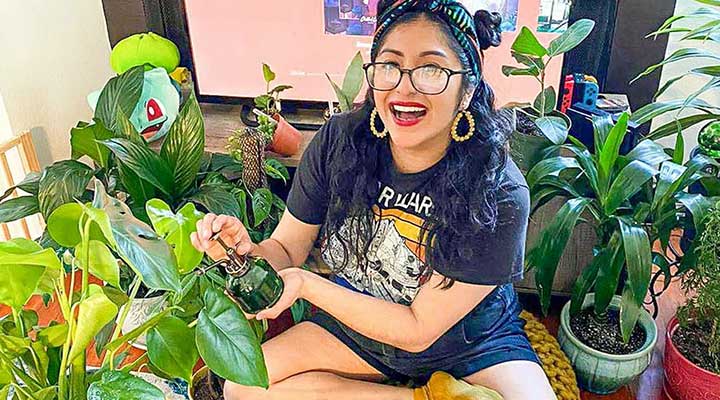
Indoor Plants for Small Spaces
Mar 31, 2023 / Liset Marquez
Indoor plants can turn your small spaces into a gorgeous jungle oasis.
Just ask Stephanie Hernandez (above) who has been able to create lush, indoor garden with 70 plants in her 600-square-foot Los Angeles apartment. She adopted the hobby as a way to reduce stress after suffering a stroke earlier this year. It’s quite a feat for someone who used to kill even potted succulents.“It really adds something to your place, and it makes you feel really happy being around this. It just adds color to everything around,”; Hernandez said.
Her passion for indoor plants is not unique. Indeed it is part of a larger trend that started years ago and bloomed bigger during the pandemic, said Rhiannon Cramm with Mickey Hargitay Plants, a nursery in West Hollywood.
“Plants provide something to look forward to as you watch them grow. They offer a feeling of being needed,”; she said. “The calm serenity that nature presents when you bring plants indoors gives most people a sense of fulfillment that is unparalleled.”;
Read on to grow your knowledge of indoor greenery, with expert tips on choosing the right plants and also making them look great in your space.
Finding the Right Space For Your Indoor Plant
Before you choose your new plants, survey your space to find spots where they are most likely to get enough natural light, whether in your living room or another part of the house. Even a bathroom can be a great place to display tropical plants, which require higher humidity.
Of course you also want to make sure you display plants so they get the attention they deserve, said Cramm.
Find places where your plants might compliment a sofa or act as a centerpiece on your end table; o even add them in a terrarium. Plants are also great on bookshelves, on floating shelves, hangars, rods, stands or on other surfaces of varying heights.
Displaying plants in this way can add vertical appeal. Macramé plant hangers are one of Hernandez’s favorite ways to do this. She can store more plants and also add height and texture to décor.
Erin Harding has a similar trick. Her husband made a platform that hangs from the ceiling of their Portland home and displays several plants.
“It’s a pretty way to display trailing plants. For anyone who has small children or pets it’s a cool way to keep them out of reach,”; said Harding, author of “How to Raise a Plant: And Make it Love You Back.”;
Harding even mounts plants that don’t require soil onto bark or a piece of wood. She did this after she ran out of space in her house of 1,200 square feet, including the garage, which she shares with her husband and young children.
“Bringing plants into your home really helps to lift your spirits and really creates a tropical feeling and it makes it bearable to get through winters,”; said Harding who documents her plant journey on her website Clever Bloom. She is also co-creator of the highly popular Instagram account House Plant Club.
Choosing the Best Indoor Plants for Small Spaces
We asked Harding and Cramm for their suggestion of best plants for small spaces, those that would be a good fit and be most likely to survive well indoors:
Sansevieria – Better known as a Snake Plant, they are usually tall but stay slim, perfect for tight spaces, or fill bare corners.
Pothos – There are many different varieties; these are great plants to hang if you have run out of floor and table space; these are also great to spill over a bookshelf.
Pilea – Dubbed the “UFO plant,”; they stay pretty compact and are great to place on a coffee table as a conversation starter. Keep your plant small by removing their babies and sharing them with friends.
Haworthia — Similar to an aloe plant, it has a wide variety of shapes and color patterns. They stay compact and are super easy to care for beginners.
Once you have you plants, you can consider storing shovels and gloves in a drawer.
Watering indoors is important but can be difficult. Consider moving plants to a balcony, tub or kitchen sink until they have soaked up the liquid.
Regardless of the plant you choose, Harding advises to give yourself a break on your plant journey.
“It’s OK to kill plants, that’s how you learn. You fail forward,”; she said.







